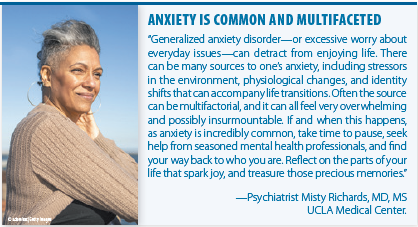Why More Women Are Diagnosed with Anxiety
Broad statistics suggest that anxiety plagues women much more than men. When the subject is explored more deeply from societal, biological, and physiological perspectives, important realities come to light. For example, compared to men, women are more likely to seek medical care, including mental health care, and therefore are diagnosed with more mental health disorders. Gender socialization norms also make it more acceptable for women to experience and express anxiety and fear in ways that are not as socially acceptable for men.
Understanding those aspects as part of the statistical reality starts to explain why reported rates of anxiety are higher in women. Then there are physiological differences in how men and women might experience stress—a triggering element in anxiety disorders. Genetics and neuroanatomical features also differ between men and women, and these sex differences influence emotional responses, says UCLA psychiatrist Misty Richards, MD, MS.
“Specifically, there are significant sex differences in the brain regions relevant to emotions. For example, where and how fear is regulated in the amygdala, hippocampus, and the prefrontal cortex differs between the sexes,” Dr. Richards explains. “Simply put, various stimuli and exposures impact these brain regions differently in men and women.
Women are exposed to far more hormonal changes than men, with major fluctuations in estrogen and progesterone during menstrual, perinatal, and menopausal cycles. Physiologically, women are inherently more vulnerable to these fluctuations, and the rapid change in hormone level is thought to be the catalyst to anxiety diagnoses.”
The Role of Serotonin
Serotonin is a neurotransmitter that also acts as a hormone. As a neurotransmitter, it performs as a messenger to transmit signals within the brain. Women are much more likely than men to suffer from serotonin deficiency. Low serotonin levels can trigger panic attacks, depression, and other signs of anxiety in women. There is also some evidence that female hormones interact with serotonin to cause anxiety symptoms to occur or worsen during the premenstrual time, the postpartum period, and around the time of menopause. In contrast, men tend to have a steady level of sex hormones until middle age, when the decline is gradual.
Unreasonable Societal Pressures
Dr. Richards points out that the societal pressures on women to navigate the hormonal perturbations and transitions of life flawlessly are unreasonable. From the onset of menses to motherhood to menopause, each one of these transitions offers a shift in identity that carries profound meaning. “It is important to normalize anxiety as a healthy response to change. I would be more concerned if a woman did not feel some level of anxiety with ‘changes of life,’” she says. “Having said that, an anxious response can quickly become unhealthy when it no longer guides decision-making, but instead interferes with it. If you find yourself in this position, realize that you are not alone and that there are multiple highly effective treatments for pathological anxiety.”
What Is Pathological Anxiety?
Anxiety can be a normal emotional reaction to a stressful situation. You may feel anxious, for example, when you’re about to speak in front of a crowd or wait in an exam room for a medical diagnosis. Many people may be uncomfortable in these situations, but they can tolerate, manage, and overcome their anxious feelings. Other people, however, can experience anxiety in an abnormal (or pathological) way. For example, some people can become hypervigilant, meaning they are constantly on guard, expecting dangerous and negative outcomes. Their worries can become irrational, even crippling, preventing them from seeking medical care, attending social events, or leaving the house. At this point, anxiety has crossed into the realm of an anxiety disorder.
The Diagnostic and Statistical Manual of Mental Disorders classifies several distinct types of anxiety disorders. Among the most common are generalized anxiety disorder (GAD), panic disorder, and social anxiety disorder. In older adults, GAD is frequently associated with traumatic events such as a fall or an acute illness. The trauma of experiencing these events may create inhibitions, such as becoming fearful of physical activity after a fall. GAD also can cross into many life domains. While most people occasionally worry about health, money, or marital problems, people with GAD persistently have a heavy sense of dread that interferes with daily life. Symptoms of GAD include feeling restless, wound up, or on edge, having difficulty concentrating, being irritable, taking frequent trips to the bathroom, experiencing sleep problems, and having headaches, muscle aches, stomachaches, or unexplained pains.
People with panic disorder have frequent, sudden, and intense feelings of fear, doom, and losing control even when there is no present danger or threat. These attacks can appear out of the blue, and the individual can experience physical symptoms that mimic a heart attack (e.g., chest pain or rapid heart rate). Making matters worse, people with panic disorder worry about the possibility of having another attack and therefore may significantly change their life situations to avoid having another attack. For example, they may forgo travel and public gatherings. Panic attacks can occur as frequently as several times a day or as rarely as a few times a year.
Social anxiety disorder is hallmarked by feeling extremely self-conscious and fearful of being judged by others. Some experts suggest that what is referred to as shyness in childhood may actually be social anxiety disorder. People with this disorder can become overwhelmed with anxiety when meeting and talking with people, especially in unfamiliar situations. While they may be able to accomplish some of these activities, they experience a great degree of discomfort and they fear that people will judge them negatively. Blushing, sweating, difficulty making eye contact, having a rigid body posture, or speaking with an overly soft voice are characteristic symptoms of social anxiety disorder.

Anxiety Disorders and Health
Those who suffer from anxiety disorders experience a greater risk of developing numerous health conditions with severe symptoms, including heart disease and gastrointestinal disorders such as irritable bowel syndrome. Numerous studies have found a link between anxiety and increased risk of cardiovascular diseases. One such study reported in the Journal of the American College of Cardiology examined Vietnam-era veterans and found that those who suffered from PTSD (a type of anxiety disorder) were more than twice as likely to suffer from coronary heart disease than those who didn’t have the disorder. Anxiety also can escalate or lead to substance use disorders, social isolation, and risk of suicide.
 Fortunately, there are treatments available. While medication is sometimes necessary to treat anxiety disorders, research shows that psychological therapy can be quite effective. Therapists help people understand their condition and teach positive and effective ways to cope with and manage anxiety. Through various methods such as cognitive behavior therapy, people can learn to understand and change thoughts that worsen their symptoms, and develop the fortitude to face an anxiety-inducing place or situation.
Fortunately, there are treatments available. While medication is sometimes necessary to treat anxiety disorders, research shows that psychological therapy can be quite effective. Therapists help people understand their condition and teach positive and effective ways to cope with and manage anxiety. Through various methods such as cognitive behavior therapy, people can learn to understand and change thoughts that worsen their symptoms, and develop the fortitude to face an anxiety-inducing place or situation.
Though some anxiety is normal, if it is persistent, overwhelming, and depletes your quality of life, seek care. With help from a mental health professional, many people learn positive coping strategies and therefore can experience a more joyful, higher quality of life.
The post Why More Women Are Diagnosed with Anxiety appeared first on University Health News.
Read Original Article: Why More Women Are Diagnosed with Anxiety »

